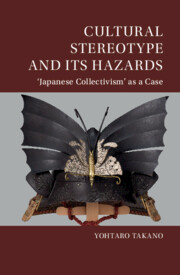Book contents
- Cultural Stereotype and Its Hazards
- Culture and Psychology
- Cultural Stereotype and Its Hazards
- Copyright page
- Contents
- Figures
- Tables
- Preface
- Acknowledgments
- Chapter 1 “Japanese Collectivism”
- Chapter 2 Psychological Studies
- Chapter 3 Japanese Culture in Real Life
- Chapter 4 Japanese Economy
- Chapter 5 Origins of “Japanese Collectivism”
- Chapter 6 Cultural Stereotype
- Chapter 7 Hazard
- Afterword
- Appendix
- References
- Index
- References
References
Published online by Cambridge University Press: 21 November 2024
- Cultural Stereotype and Its Hazards
- Culture and Psychology
- Cultural Stereotype and Its Hazards
- Copyright page
- Contents
- Figures
- Tables
- Preface
- Acknowledgments
- Chapter 1 “Japanese Collectivism”
- Chapter 2 Psychological Studies
- Chapter 3 Japanese Culture in Real Life
- Chapter 4 Japanese Economy
- Chapter 5 Origins of “Japanese Collectivism”
- Chapter 6 Cultural Stereotype
- Chapter 7 Hazard
- Afterword
- Appendix
- References
- Index
- References
- Type
- Chapter
- Information
- Cultural Stereotype and Its Hazards‘Japanese Collectivism' as a Case, pp. 249 - 278Publisher: Cambridge University PressPrint publication year: 2024

